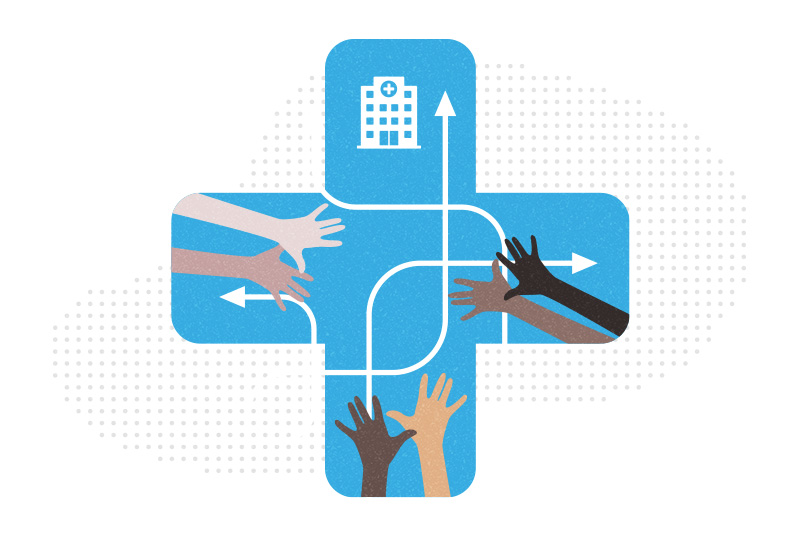Revisiting race and ethnicity in clinical guidelines

Health care institutions often rely on clinical pathways in assessing patients and making decisions about their care. Some of these care algorithms incorporate race, ethnicity, or ancestry as factors in decision making. But is this helpful or harmful? And is there solid evidence to justify treating people of different racial or ethnic backgrounds differently?
Robert Hsu-Wei Rosen, MD, a pediatric emergency medicine fellow, and Amy Starmer, MD, MPH, the prior medical director of the Clinical Pathways Program at Boston Children’s Hospital, explored these questions using a structured approach, which they share in the December issue of Pediatrics. It ultimately led them to revise or remove references to race, ethnicity, or ancestry in a number of pathways used at Boston Children’s.
“No one had previously published a practical framework for how to do this,” says Rosen. “We hope to empower other institutions to evaluate their pathways.”
Exploring race and ethnicity in medicine
In a systematic national review in 2022, about 30 percent of pediatric clinical guidelines included a race or ethnicity term. At Boston Children’s, the conversation started with a group of clinicians who questioned a clinical pathway for urinary tract infection (UTI), which made it less likely that Black patients would have a urinalysis.
“The original UTI pathway included ‘Black race’ as a criterion without any acknowledgment of the fact that race is a social construct without biological underpinnings,” says Alexandra Epee-Bounya, MD, a member of this group of clinicians who later played a key leadership role in the working group effort. “It also required the pathway user to assign a race to the patient possibly without the family’s input. We hoped to bring awareness to the high potential for bias (and inequitable care) that this had.”
Starmer and Rosen formed a working group comprised of more than 30 racially and ethnically diverse clinicians, including primary care pediatricians, emergency medicine physicians, hospitalists, infectious disease physicians, and experts in health equity, quality improvement, and safety.
The group began by reviewing all 132 established clinical pathways used at Boston Children’s — ultimately identifying eight pathways that included a reference to race, ethnicity, or ancestry. The group then examined each pathway with a structured process, asking:
- Why were race and ethnicity terms included, and based on what evidence?
- What is the strength of the evidence?
- Is there a plausible biological mechanism for the racial or ethnic difference?
- Is including race or ethnicity likely to relieve or exacerbate health inequities?
“A nuanced approach was needed to evaluate whether modifications to identified references were warranted,” says Starmer, who continues to do research at Boston Children’s.
The team ultimately removed or modified references to race, ethnicity, or ancestry for the eight pathways, including the UTI pathway.
Biology vs. social determinants of health
Conversations around race and ethnicity in medicine often conflate the social construct of race with biology. Yet people identifying as the same race can have widely divergent genetic ancestry, and some people identifying as different races may overlap more genetically with each other than individuals of their own race. In Starmer and Rosen’s review, disentangling race from biology and identifying social determinants of health that explain racial and ethnic disparities was key.
In several conditions, the pathway directed more testing and treatment to patients in historically marginalized ethnic or racial groups:
- The weight management pathway, based on American Diabetes Association guidelines, listed “Native American, African American, Latino, Asian American, or Pacific Islander” as an indication for type 2 diabetes screening if paired with an additional risk factor. The working group concluded that there is no biological justification for this assumption. Instead, they modified the pathway to indicate that any racial and ethnic disparities likely stem from factors like access to health nutrition and activity.
- The acute viral illness pathway, based on an American Academy of Pediatrics guideline, stated that American Indian or Alaska Native patients should be prioritized for antiviral medications and vaccines. Noting strong evidence that risk of severe influenza is driven by economic status, access to care, and medical comorbidities like asthma and obesity that themselves are linked to socioenvironmental factors, the team modified the pathway.
The diabetes pathway did the opposite. Its scoring tool was more likely to recommend a diabetes-associated antibody panel for white patients than for other racial or ethnic groups. Boston Children’s experts concluded that all children should get this screening and removed the tool from the guideline.
When race and ethnicity are irrelevant at best
For other conditions — like pregnancy and fever of unknown origin — the pathway linked to a template that asked about race and ethnicity without indicating how this information might be germane to the patient’s care. The team removed this link, concerned that soliciting this information can perpetuate biological racism and create distrust in families, with no benefit to the patient.
The eczema treatment pathway, meanwhile, stated that “Asian, Black Caribbean, and Black African” children may have a different distribution of lesions. The team removed this statement as not relevant to treatment.
The hyperbilirubinemia pathway recommended identification of “East Asian ancestry” without saying how this information would be applied in deciding when to stop light therapy in infants receiving this treatment. The team concluded that race and ethnicity did not improve decision making and removed the term.
Key takeaways for clinicians
- Race does not equal biology. Race is a social construct that artificially separates individuals based on perceived physical characteristics. Though it has no biological basis, people have used race as a flawed proxy for genetic differences. Some have argued that inquiring about ancestry instead can help uncover genetic factors, but this too has pitfalls, as many people don’t know their ancestry precisely.
- Root cause matters. Racial and ethnic disparities often arise from social and economic factors that affect health and access to care. With better research on these social and economic factors, clinicians can replace the question “What is your race and ethnicity?” with better questions like “Where do you work?”, “Do you have a primary care doctor?”, and “Are you going to be able to pick up that medication?”
- Beware of applying population data to individuals. Population data represent an average, and there are pitfalls in applying such data to individuals with unique circumstances that affect their health risk.
- Examine the impact: Race and ethnicity guidelines should be removed when they don’t clearly benefit the patient, even when they call for more testing or treatment. More treatment is not necessarily better treatment.
Many members of the working group found the process of rethinking clinical pathways to be eye-opening.
“Some of the assumptions have been propagated year over year, and it’s important to think about how we got to where we are,” says Rosen. “You have to find what accounts for disparities, and if you adjust your pathway, will it alleviate or exacerbate disparities? As a physician, what this process gives you is a lot of humility.”
Learn more about the pathways evaluation framework and the Office of Health Equity and Inclusion at Boston Children’s.
Related Posts :
-

Bringing equity to genomic sequencing in newborns: BabySeq 2.0
Today, nearly 900 disorders caused by a single gene are known to be treatable. Yet the recommended “heel stick” testing for ...
-

Clinical trials in children: Is there racial equity?
The treatments and interventions used in medicine are often based on the results of clinical trials. But trials involving adults ...
-

Addressing racial and ethnic health disparities within primary care
The COVID-19 pandemic has led to increased awareness of existing racial and ethnic health disparities and inequities. The team at ...
-

Infantile spasms: Speeding referrals for all infants
Infantile epileptic spasms syndrome (IESS), often called infantile spasms, is the most common form of epilepsy seen during infancy. Prompt ...





